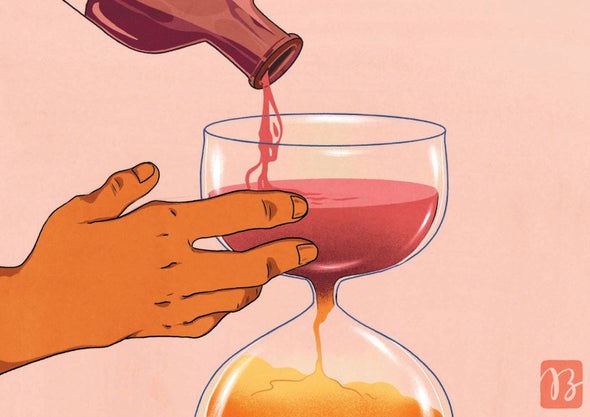How to Figure Out if Moderate Drinking Is Too Risky for You
How to Figure Out if Moderate Drinking Is Too Risky for You Scientific American


Even Moderate Drinking Has Risks

Wine with dinner is a lovely thing. I enjoy a glass or two, though rarely more. I have seen the terrible toll of alcohol use disorder and know the risks. Or I thought I did. I judged my drinking “moderate” and relatively benign.
A decade ago scientists and public health experts agreed with me. A drink or two a day was safely within most public health guidelines, and research even suggested that a little alcohol could protect against cardiovascular disease.
But earlier this year the World Health Organization (WHO) stated any amount of alcohol was dangerous. “There is no safe amount that does not affect health,” the group declared. Canadian authorities redefined moderate-risk drinking as three to six drinks a week, down from a daily level of two for women and three for men. The U.S. now recommends a limit of one drink a day for women (that is, 12 ounces of beer, five ounces of wine or 1.5 ounces of spirits) and two for men. The message is clear: the chances of harm begin with the first drop.
The Sustainable Development Goals (SDGs)
- Goal 3: Good Health and Well-being
- Goal 5: Gender Equality
- Goal 13: Climate Action
This radical shift in thinking made headlines. Then my own doctor advised me to cut back. I was willing, but I wanted to understand what, exactly, I was risking with each sip of sauvignon blanc.
Previous health advice was designed to stop people from becoming alcoholics, says psychologist Tim Stockwell of the University of Victoria, a former director of the Canadian Institute for Substance Use Research, who has helped develop guidelines for three countries over 25 years. “It wasn’t so much how you protect your body from cancer, liver disease, or losing a few months or even years of life expectancy.”
Now a growing body of research says any alcohol raises the chance of premature death from a variety of causes. About half of cases of liver disease are attributed to drinking. Alcohol is also a potent carcinogen. It can cause cancer because it breaks down in the body to form a compound called acetaldehyde, which damages DNA. That damage can lead to at least seven types of cancer. Fifteen percent of breast cancers are linked to alcohol. And according to the WHO, half of cancers in Europe linked to alcohol are caused by “light” or “moderate” consumption.
These risks seem to cancel out evidence of alcohol’s cardiovascular benefits, which was weakened anyway when researchers did more nuanced studies. The heart-protective theory was based on the finding that moderate drinkers had better cardiovascular health than both nondrinkers (by a little
SDGs, Targets, and Indicators Analysis
1. Which SDGs are addressed or connected to the issues highlighted in the article?
- SDG 3: Good Health and Well-being
- SDG 12: Responsible Consumption and Production
The article discusses the health risks associated with alcohol consumption, which is relevant to SDG 3. It also addresses the need for responsible consumption of alcohol, connecting to SDG 12.
2. What specific targets under those SDGs can be identified based on the article’s content?
- SDG 3.5: Strengthen the prevention and treatment of substance abuse, including narcotic drug abuse and harmful use of alcohol
- SDG 12.8: Ensure that people everywhere have the relevant information and awareness for sustainable development and lifestyles in harmony with nature
The article highlights the need to address the harmful use of alcohol, which aligns with SDG 3.5. It also emphasizes the importance of providing accurate information about the risks of alcohol consumption, which relates to SDG 12.8.
3. Are there any indicators mentioned or implied in the article that can be used to measure progress towards the identified targets?
Yes, the article mentions several indicators that can be used to measure progress towards the identified targets:
- Number of cases of liver disease attributed to drinking
- Percentage of breast cancers linked to alcohol consumption
- Number of premature deaths attributed to alcohol consumption
- Level of awareness among the population about the risks of alcohol consumption
These indicators can be used to track progress in preventing and treating substance abuse, as well as raising awareness about the risks of alcohol consumption.
SDGs, Targets, and Indicators Table
| SDGs | Targets | Indicators |
|---|---|---|
| SDG 3: Good Health and Well-being | 3.5: Strengthen the prevention and treatment of substance abuse, including narcotic drug abuse and harmful use of alcohol | – Number of cases of liver disease attributed to drinking – Percentage of breast cancers linked to alcohol consumption – Number of premature deaths attributed to alcohol consumption |
| SDG 12: Responsible Consumption and Production | 12.8: Ensure that people everywhere have the relevant information and awareness for sustainable development and lifestyles in harmony with nature | – Level of awareness among the population about the risks of alcohol consumption |
Behold! This splendid article springs forth from the wellspring of knowledge, shaped by a wondrous proprietary AI technology that delved into a vast ocean of data, illuminating the path towards the Sustainable Development Goals. Remember that all rights are reserved by SDG Investors LLC, empowering us to champion progress together.
Source: scientificamerican.com

Join us, as fellow seekers of change, on a transformative journey at https://sdgtalks.ai/welcome, where you can become a member and actively contribute to shaping a brighter future.







